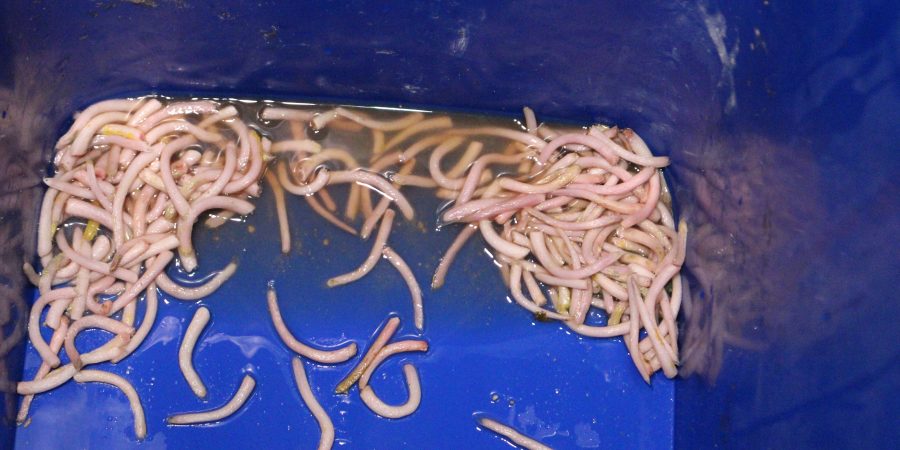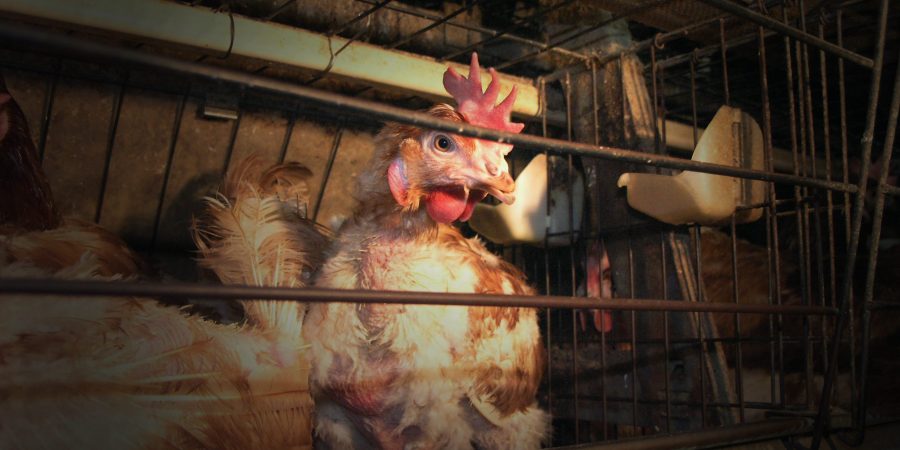If the tail were cut off a dog or cat, it would be considered prosecutable cruelty. But for animals categorised as ‘food’ rather than ‘friend’, painful surgical mutilations are sadly part of their unnaturally short lives…
The drive to maximise production and profit in the meat, eggs and dairy industries has led to routine farming practices that completely disregard the welfare of animals. These practices are anything but ‘normal’, but they have sadly become the ‘norm’ in farming today.
How is this allowed to happen? Farming industries have been given exemptions to the cruelty laws that apply to our companion animals, leaving farmed animals exposed to immense suffering. Most farmed animals are forced to endure these procedures without any pain relief, despite pain relief products being affordable and readily available for use in Australia.
Read on to find out the types of procedures cattle, sheep, pigs, and hens are subjected to on Australian farms:
Cattle
Dehorning
When a cow is ‘dehorned’, her horns and the sensitive tissue near her skull are cut, sawn, or scraped out. Knives, wires, saws and shears, and even ‘scooping’ implements, are commonly used. Dehorning is one of the most traumatic experiences cattle are forced to endure, but there are no laws requiring them to receive any pain relief.
In the dairy industry, young ‘heifer’ calves often suffer a similarly painful practice called ‘disbudding’. This usually involves either a hot iron being pressed against their head to permanently damage their horn ‘buds’, a caustic chemical being applied, or their sensitive horn tissue being scraped out of the recess in their skull.
Dehorning is intended to make cattle easier to handle and prevent injuries during transport, or if they are forced into crowded feedlots – times when these animals are understandably stressed and scared.
A cow’s horns are connected to their sinuses; when cut off (especially if they are older) their frontal sinuses can be damaged and exposed, placing them at risk of infection and extreme bleeding. As a result, their painful wounds can take much longer to heal.
Branding
On many farms, calves are forced to endure dehorning, castration, ear notching and branding all at once. One by one, they are pinned down, or squeezed in a ‘crush’ pen; their horns are cut off; (if they are male) their testes are cut out; their ears notched, and a red hot iron is seared into their skin, leaving a permanent mark.
The branding iron may alternatively be dipped into a coolant, such as liquid nitrogen before being pressed against the calf’s skin. While freeze branding is initially less painful, both forms of branding can cause ongoing pain. Poorly maintained branding irons and the stress caused to animals during handling and restraint can all lead to further injuries.
Castration
A male calf’s genitals are some of his most sensitive organs. When older bulls are castrated, it is considered a major surgical procedure, which only a vet can perform. Yet most young calves suffer this invasive procedure at the hands of farm workers without any sedative or pain relief.
Young calves bellow in pain as their scrotums are cut open, and their testes pulled out and cut off. Alternatively, calves may have a rubber ring constricted tightly around their scrotum to stop blood flow, eventually leading to their testicles falling away.
For many calves, the cruel procedure is only the beginning. Castrated calves can suffer from inflammation, infection and chronic pain. Sometimes, the complications from this surgery can even be fatal.
Spaying
On large northern Australian (beef) cattle stations some cows (around half a million a year) are subjected to spaying — an invasive procedure which requires the surgical removal of the ovaries, either via a cut through the flank or via the vagina/womb. This is currently done without any requirement for pain relief and carries a high risk of infection and even death.
Sheep
Live lamb cutting (known as ‘mulesing’)
Young lambs often have the skin around their buttocks and the base of their tail cut off with a pair of metal shears (to reduce soiling and the risk of flystrike). The large, open wound created by ‘mulesing’ can take many weeks to heal. During this time, lambs are at added risk of infection and flystrike.
While mulesing is inflicted on lambs to reduce flystrike, it is a human-created problem and solutions that are less invasive and painful exist. Merino sheep traditionally had smooth skin; in the 1880s, Australian producers began selectively breeding sheep with excessive amounts of skin, believing more wool could be harvested from sheep with more skin.
This painful practice has been banned in New Zealand on cruelty grounds. The Australian wool industry committed to phasing out mulesing, but later backflipped on its commitment, and in 2016, would not even support the mandatory use of pain relief for mulesed lambs. Over 140 million lambs have undergone live lamb cutting since 2010, many with no pain relief whatsoever.
Thanks to tireless animal advocates speaking out, Victoria and Tasmania recently became the first states to require at least some pain relief for the procedure.
Shearing
Shearing is stressful for sheep, who aren’t used to human handling, and rough treatment in the shearing shed also puts them at risk of injury. Sheep are often cut by the sharp shearing blades, and when they suffer larger wounds, it is considered acceptable industry practice to stitch them up without providing any pain relief.
As with those who carry out other painful, invasive procedures, there is currently no requirement for shearers to undergo formal training and accreditation.
Tail docking
Like puppies, lambs are born with a long tail. But most lambs are put in a restraint device and have their tail cut off (called docking) to reduce soiling and the risk of flystrike. When lambs are less than six months old (which is the norm), this practice can be done without anything to reduce the pain. Often lambs are also mulesed at the same time.
A hot blade or sharp knife is used to cut through the muscle and bone of the lamb’s tail. On some farms, lambs will instead have a rubber ring tightened around their tail so that it will wither and drop off.
If a lamb’s tail is cut too short, they are at higher risk of suffering from serious health complications, such as rectal prolapse or skin cancer in older ewes.
Castration
Male lambs usually have to endure both castration and tail docking (and sometimes mulesing) at the same time, without any pain relief if done prior to six months of age. When these procedures are carried out by unskilled people, the risk of greater injury, and infection is even more significant.
Invasive breeding procedures
Female sheep (ewes) are also often forced to endure invasive procedures. In one common breeding procedure, called laparoscopic artificial insemination, a long metal rod is poked through the ewe’s abdomen to insert semen into her uterus. This invasive procedure can be done without pain relief.
Pigs
Tail docking
Pigs are known to be intelligent, highly social and inquisitive animals – and they can quickly become bored and even aggressive when confined to barren pens in factory farms. Tail biting is one way that pigs can try to vent their frustrations. Instead of giving them more space, the pig industry routinely cuts off their tails, through bone, when they are only days old.
This image contains content which some may find confronting

Tail docking causes acute stress in piglets, who respond by squealing and ‘scooting’ – sitting and dragging their bottoms along the floor. The procedure can also cause neuromas to develop at the wound site, which is associated with increased sensitivity to pain long-term.
Teeth clipping
A mother pig with suckling piglets in the wild will stand and move away when she needs a break, and nudge piglets when they bite her nipples or their littermates. But sows confined in farrowing crates are unable to move sufficiently (or even turn around) — so they endure on-demand suckling and cannot teach their piglets to be gentle. The industry solution is to grind and clip piglets’ teeth, making them blunt to lessen the injuries they can cause. Teeth clipping is very painful and can lead to gum and tongue injuries, inflammation and abscesses of the teeth, and enduring pain for many weeks before their milk teeth are shed.
Castration
Male piglets can also be surgically castrated to reduce the risk of ‘boar taint’ – a smell and taste that’s considered undesirable in their meat from hormones and other compounds naturally produced during puberty.
Because pigs have been selectively bred to grow quickly and be slaughtered young, relatively fewer male pigs are now subjected to this painful procedure (but it is still legally permitted, without pain relief up to 21 days of age).
Hens
Beak cutting
In densely packed, confined living spaces, hens inevitably become frustrated, which can lead to them pecking each other. The industry’s ‘solution’ to this is ‘debeaking’ or beak trimming, which involves removing the end of a young hen’s beak in an attempt to limit the injuries caused. A hot blade or infrared laser is usually used to perform the procedure on chicks, and it is done without any pain relief.
This image contains content which some may find confronting

A chicken’s beak (like that of all birds) is a complex, sensitive structure. Chickens use their beaks to grasp and manipulate food, nest, and preen their feathers. The beak-trimming procedure causes the birds to feel acute and often chronic pain and also impacts their welfare by hindering the functioning of their beaks.
Help shape a kinder future for farmed animals
The animals trapped in our outdated food system are capable of experiencing joy and suffering, just like the companion animals we share our homes and our hearts with. But categorised as ‘food’ rather than ‘friend’, these animals are seen as things to be used, instead of the sensitive and social individuals they are.
We didn’t choose this way of thinking; we inherited it from those before us – and thankfully, it doesn’t have to stay this way.
With some simple changes to the way we eat and live, we can create a kinder world for farmed animals (as well as wildlife and humans, too!).
Get your free guide today. Nearly there! Thank you ! Thank you!

Keep an eye out for your free magazine, it will be with you soon. Help us spread the word!








